
Gillray on…Royalty and Aristocracy.
Gillray’s work was almost unprecedented for the caustic way in which it decried the royal family. Although caricaturing the monarchy was not invented by Gillray, he brought the act to a daring and personal level.
His depictions of the hapless King George III are among his most humorous and famous works. Gillray exploited George III’s reputation for austerity and miserliness unbefitting of his status. Moreover, the King’s bouts of madness and his reputedly ugly and dull wife, Queen Charlotte, were a gift to the Georgian caricaturist. Gillray made full use of his skills in exaggerating her goggling eyes and pointed chin.
In contrast, their son, the Prince of Wales, detested his parents and their lifestyle, and lived a life of debauchery and excess. This was equally a source of ridicule in Gillray’s work.
However, following the beginning of hostilities with France in 1793, Gillray moderated his attitude towards the royal family. Although the English nation was represented most frequently by the fictional John Bull, George III occasionally stood in a proxy, portrayed in a simple, yet affable and harmless manner as ‘Farmer George.’
Not only was Gillray concerned with political events of the time, he was also enthralled by the absurd antics and follies of the Georgian aristocracy. In particular, the fops and society figures who frequented the area of London around Bond Street and St. James. Gillray lived in the area and found it captivating to observe this foolish behaviour and recreate it in ludicrous images in his own inimitable, ruthless style. His subjects, in a suitably egotistic manner, were more than eager to purchase the unrelenting prints.
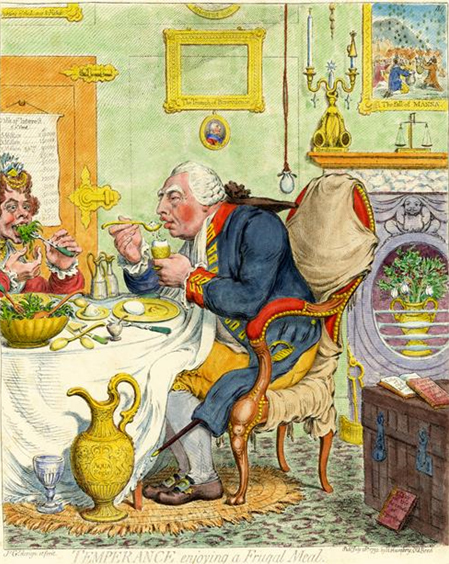
James Gillray: The Man Behind the Mischief…
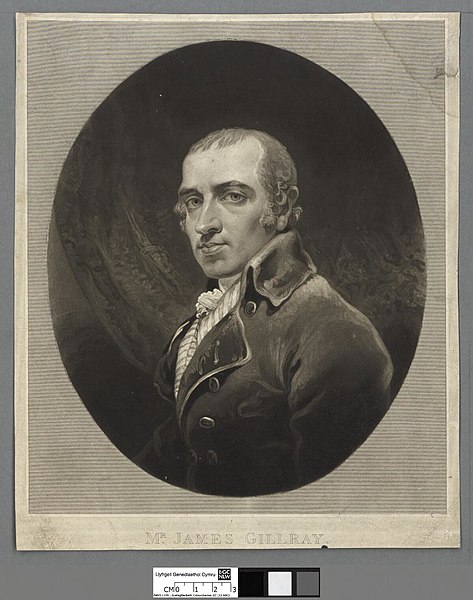
James Gillray (1756 – 1815) was a caricaturist of unparalleled popularity and international repute during and after his lifetime. Active during the tempestuous ‘Age of Revolution’, he built on the tradition of visual satire and himself revolutionised the art of personal caricature, skewering the recognisable elite and everyday with his acerbic and sometimes controversial craft and wit.
Born into a strict Moravian home in Chelsea, James Gillray’s early life was joyless and austere. His artistic skill, however, become clearly visible from a very early age. He gained an apprenticeship as an engraver and in 1778 was admitted to the Royal Academy Schools in London. Although initially attempting to distance himself from the ‘low’ form of satirical art, the monotony of ‘serious’ artistic work and the public appetite for the bawdy drew him to the style that would define (and be defined by) him.
These works of satire often depicted scenes which could be described as vulgar and somewhat pornographic in nature, showing perverse scenes in and around seedy, low-life establishments. He was also gifted material in the political strife and aristocratic melodramas of the times on both sides of the Atlantic. His personal, instantly recognisable caricatures of ‘celebrities’ such as Napoleon, King George III, William Pitt the Younger, and the symbolic figure of John Bull were a particular forte.
Working with several London publishers, Gillray’s more popular images were housed and sold by Hannah Humphrey, with whom the artist lodged and was reputed to have had a personal involvement with. She became the exclusive seller of his prints from 1791.
His personal character, perhaps fuelled by memories of his severe upbringing, was, in stark contrast to his art, morose and solitary, exacerbated by an excessive drinking habit. His health became affected, impacting on the quality and quantity of his output, and by about the end of 1811 he sank almost into imbecility. He died on 1st June 1815 aged 58 years old.
A Voluptuary under the Horrors of Digestion
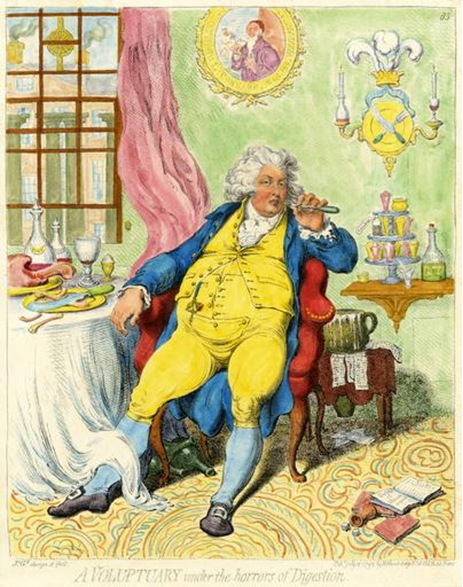
Gillray here depicts an obese George, Prince of Wales and later Prince Regent and George IV. A man renowned for his self-indulgence and wantonness, he reclines in his dining chair having gorged himself on a huge meal. Previously regarded as possessed of striking good looks, the Prince’s corpulence and greed as he approached 30 is mercilessly satirised; his waistcoat barely fastened over his distended stomach as he rudely picks his teeth with a fork.
The scene is set amid obvious symbols showing the detritus of debauchery: the overflowing chamber pot covering lengthy unpaid bills; emptied flagons of wine peeping out from beneath the tablecloth; dice thrown on the floor next to debtors’ notes and ‘The Newmarket List’, highlighting his penchant for gambling.
On the wall to the right, we see the Prince of Wales’ coat of arms parodied by the introduction of a crossed knife and fork and the candles held in a wine glass and decanter. Beneath this rests a stand holding jelly glasses, amongst which is placed a small pot labelled ‘For the Piles’ , another with a tag ‘For a Stinking Breath’, and a tub of pills and a decanter etched with ‘Velnos Vegetable Syrup’, all of which would indicate that his grossly unsavoury lifestyle had led to unpleasant health problems.
A Connoisseur examining a Cooper
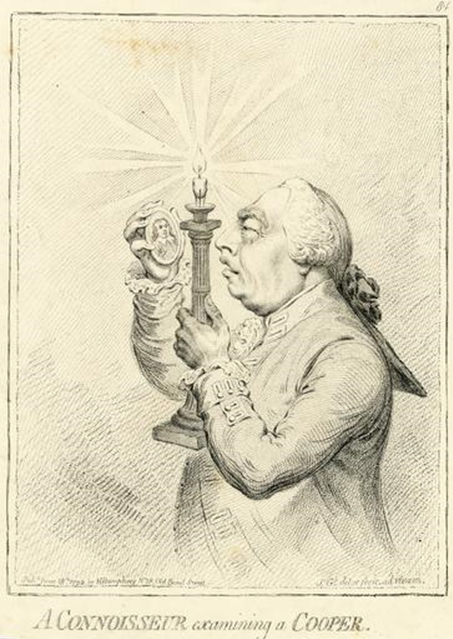
Gillray depicts King George III examining Samuel Cooper’s famous miniature portrait of Oliver Cromwell. The King was a great supporter of the Arts and had, in 1768, given his signature to the foundation of the Royal Academy of Arts, contributing drawings, books and antique casts from his own collection to the Royal Academy Schools. He considered himself a connoisseur and favoured the flamboyant style of Allan Ramsay and the Neo-classicism in the work of Benjamin West.
Already prejudiced against Gillray for his political prints and satires of the royal family, the King was said to have blithely and dismissively declared after examining some of the satirist’s sketches, “I don’t understand these caricatures!”
Gillray duly sought his revenge in this print. The profiled figure of the monarch scrutinises the instantly recognisable image of Cromwell by candle-light; the most famous of the English Monarchy’s adversaries. Although painted by Cooper “warts and all” at his own insistence, Cromwell by Gillray’s hand appears almost regal in contrast to the oafish visage of the King peering on. Designed to question his connoisseurship, the context of the monarchy fearing a new English Revolution sparked by events in France would equally not have been lost on a contemporary audience.
Even the candle is intended as a jibe at the King, held as it is in a ‘save-all’ candlestick. This was a device designed to use up the last fragments of a candle by collecting the melted wax. The witticism here refers to the notorious frugality of the King and his household.
Gillray on…Politics
With his adult life spanning the four decades between the American Revolution and the Battle of Waterloo, Gillray lived in a time well suited to the development of his craft and ‘maturation’ of his political satires.
During the 1780s and 90s, the artist was mainly preoccupied with domestic politics. The party divisions were embraced by Gillray, who regularly attended the House of Commons with small sketch cards to refine his portrayal of certain political figures. Whigs such as Charles James Fox and reformist Francis Burdett, or the Tory Prime Minister William Pitt the Younger, were gifted orators and committed to their respective causes. More importantly for Gillray, they also had easily caricatured habits and appearances.
However, any overt allegiance to one political stance seems motivated by commercial interests. In 1797, when The Anti-Jacobin magazine was launched by future Tory Prime Minister George Canning, aimed at discrediting the opposition, an annual pension to Gillray of £200 for submissions earned the Tories a temporary loyalty. Speaking to a friend who had commented upon his apparent disdain for the Whig party, Gillray responded that “they are poor, they do not buy my prints, and I must draw on the purses of the larger parties.”
With the death of two of his great subjects Fox and Pitt in 1806, followed closely by the decline of Lord Grenville’s ‘Ministry of All the Talents’ in 1807, Gillray’s enthusiasm for politics waned. Many of his later works turned back towards social and moral satire rather than depicting the high drama of English politics. These were consistent only in their championing of virtue through the denunciation of vice, excesses of those in authority, and sympathy with the victims of oppression.
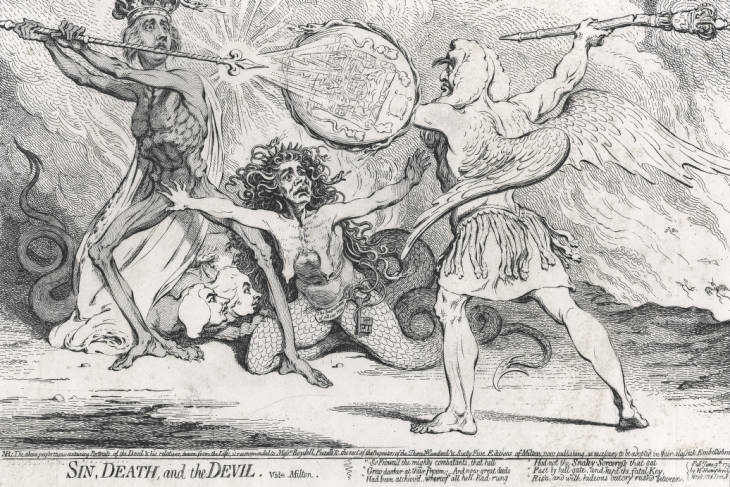
The Revolution will be Satirised
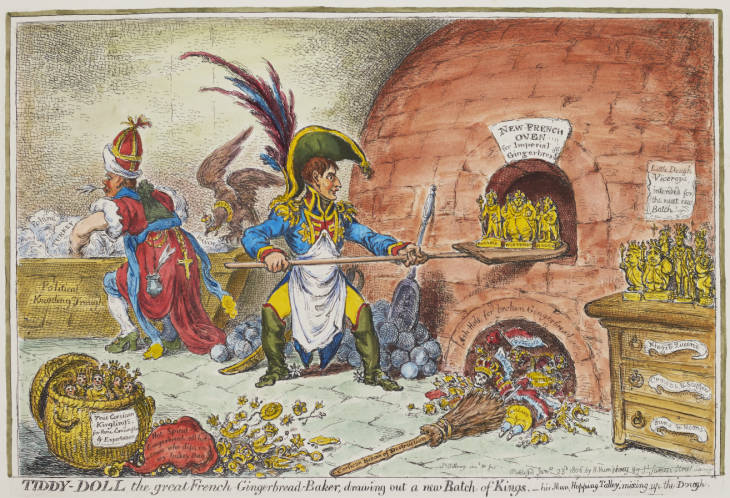
From the outbreak of the French Revolution until the end of his career in 1810, much of Gillray’s output was propagandist, being concerned with the momentous events across the channel. Like many, Gillray appears to have been initially in sympathy with the leaders of the French Revolution, but quickly grew disillusioned as events grew bloodier with the Jacobin extremists in late 1792; especially as it seemed France might increasingly pose a threat to British security. As a result, Gllray’s Frenchman were quickly turned into his stereotypically sub-human sans-culottes; depraved, malnourished, hairy, child-eating and with teeth and nails filed to points.
The central focus of Gillray’s sarcasm and ire eventually found a home in Napoleon. Although Gillray had never seen him in the flesh, he conjured up an iconic and instantly recognizable recurring figure, taken up by many of Gillray’s contemporaries and immortalised as ‘Little Boney.’ As his threat to Britain increased, Gillray reduced Napoleon’s physical stature accordingly.
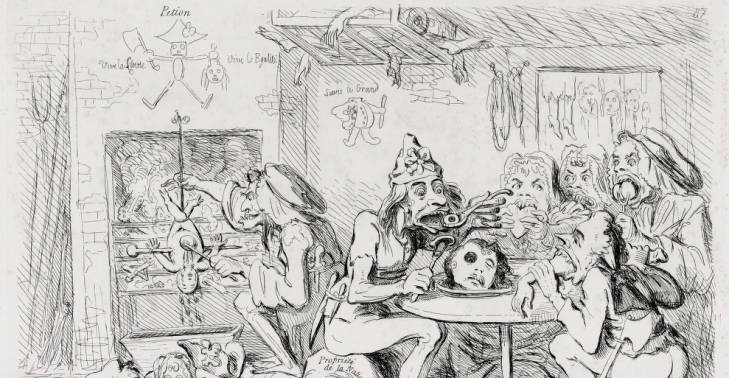
John Bull Taking a Luncheon
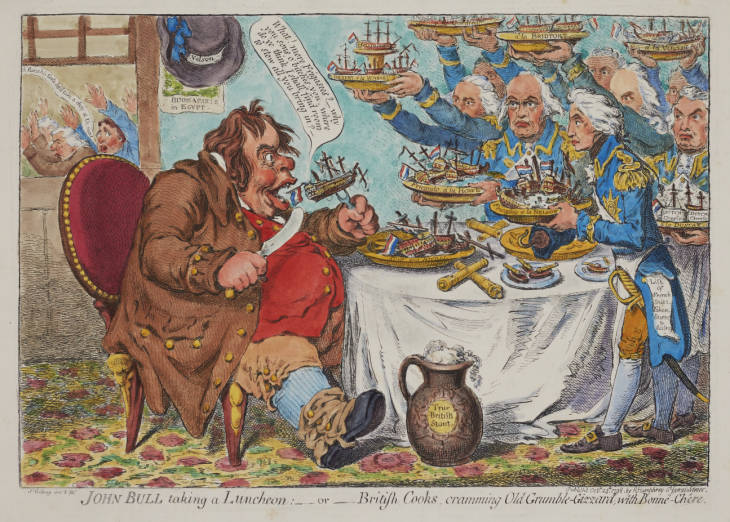
This print celebrates the victory of the British navy at the Battle of the Nile in August 1798, with Gillray exalting their achievements with nationalistic fervour.
The main figure depicted is John Bull, a regular in Gillray’s work used to personify England. Here, appearing as Old Grumble-Gizzard, Bull sits at a table spread with cannons, battered ships and side dishes including gun-boats, complaining ungraciously about the excess of victories on offer.
Opposite Bull, Lord Horatio Nelson offers a main course of Fricassée à la Nelson, while a List of French Ships Taken Burnt and Destroyed hangs from his pocket. A variety of further dishes are proffered by other heroic British admirals symbolizing previous naval triumphs. A large frothing jug of True British Stout on the floor decorated with the Royal Arms further reinforces the exaltation of British superiority, while, outside the window, members of the opposition, including Charles James Fox, are seen in flight .
The New Dynasty; – or – the little Corsican Gardiner planting a Royal Pippin Tree
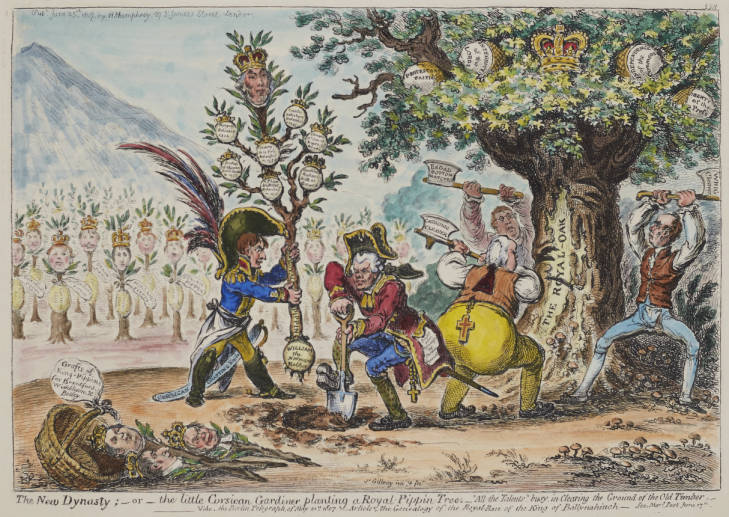
This print depicts Napoleon planting new dynasties in his expanding Empire with the help of his his Minister of Foreign Affairs Talleyrand. The Pippin Tree represents the genealogy of Lord Moira, who was seen as a Whig overly sympathetic to the French and boastful of his own supposed royal lineage. The “”Royal Oak”” of British constitutionalism is hacked at by supposed domestic sympathisers; fellow Whig MPs Lord Howick, Lord Grenville, and the Marquis of Buckingham.
Details shown below;
The Royal Pippins

The royal pippins behind Napoleon, which have already been planted and have taken root, forming the ‘Imperial Garden.’ Already grafted are the rulers for Etruria, Wurtemburg, Saxon, Holland, and Italy—Napoleon’s Empire at the time of publication.
The Royal Pippin Tree

The Royal Pippin Trees itself bears the crowned head of Lord Moira and the brances and roots bear derogatory memorials of his ancestors, including William the Norman Robber (William I) and Crooked backed Richard (Richard III). Gillray implicates Lord Moira as a Whig overly sympathetic to the French and boastful of his own supposed royal lineage.
‘Grafts of King Pippins’

Gillray highlights the potential future nature of Napoleon’s threat to Britain as on the ground we see a basket labelled ‘Grafts of King Pippins for Brentford, Wimbledon, and Botley’, and carries the crowned heads of prominent reformists (all charged with treason) Horne Tooke, Cobbett, and Burdett.
Napoleon planing a new Royal Pippin Tree

Gillray satirizes the direction of Napoleon’s ambitions by showing him planting a new Royal Pippin Tree to create new royal dynasties himself. Napoleon achieves this with the help of his Corsican Grafting Knife; a poke at his own, less grand lineage.
Talleyrand, Minister of Foreign Affairs

Napoleon is assisted by his Minister of Foreign Affairs, Talleyrand, a skilled and influential diplomat, who digs the hole for his Emperor. In his pocket, a piece of paper reads ‘projet pour aggrandiser les Jardins Imperials’, roughly translated as project to aggrandise the Imperial Gardens.
Lord Howick, the Marquis of Buckingham

The oak is being hewn by Lord Howick, the Marquis of Buckingham, and Lord Grenville; representing some of the ‘Ministry of All the Talents’, founded upon the death of Pitt. Grenville has a crucifix hanging from his back and wields a Catholic Cleaver, indicating his unpopular support for Catholic Emancipation.
Chopping down of the Royal Oak

Meanwhile, the Royal Oak is being chopped down. Representing the British monarchy, it also bears the fruit of ‘Protestant Faith, Integrity of the Lords, Liberty of the Press and Independence of the Commons’, thereby also symbolising the British constitution.
